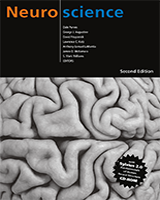By agreement with the publisher, this book is accessible by the search feature, but cannot be browsed.
NCBI Bookshelf. A service of the National Library of Medicine, National Institutes of Health.
Purves D, Augustine GJ, Fitzpatrick D, et al., editors. Neuroscience. 2nd edition. Sunderland (MA): Sinauer Associates; 2001.

Neuroscience. 2nd edition.
Show detailsThe taste system, acting in concert with the olfactory and trigeminal systems, indicates whether food should be ingested. Once in the mouth, the chemical constituents of food interact with receptors on taste cells located in epithelial specializations called taste buds in the tongue. The taste cells transduce these stimuli and provide additional information about the identity, concentration, and pleasant or unpleasant quality of the substance. This information also prepares the gastrointestinal system to receive food by causing salivation and swallowing (or gagging and regurgitation if the substance is noxious). Information about the temperature and texture of food is transduced and relayed from the mouth via somatic sensory receptors from the trigeminal and other sensory cranial nerves to the thalamus and somatic sensory cortices (see Chapters 9 and 10). Of course, food is not simply eaten for nutritional value; “taste” also depends on cultural and psychological factors. How else can one explain why so many people enjoy consuming hot peppers or bitter-tasting liquids such as beer?
Like the olfactory system, the taste system includes both peripheral receptors and a number of central pathways (Figure 15.10). Taste cells (the peripheral receptors) are found in taste buds distributed on the dorsal surface of the tongue, soft palate, pharynx, and the upper part of the esophagus (Figure 15.10A; see also Figure 15.11). These cells make synapses with primary sensory axons that run in the chorda tympani and greater superior petrosal branches of the facial nerve (cranial nerve VII), the lingual branch of the glossopharyngeal nerve (cranial nerve IX), and the superior laryngeal branch of the vagus nerve (cranial nerve X) to innervate the taste buds in the tongue, palate, epiglottis, and esophagus, respectively. The central axons of these primary sensory neurons in the respective cranial nerve ganglia project to rostral and lateral regions of the nucleus of the solitary tract in the medulla (Figure 15.10B), which is also known as the gustatory nucleus of the solitary tract complex (recall that the posterior region of the solitary nucleus is the main target of afferent visceral sensory information related to the sympathetic and parasympathetic divisions of the visceral motor system; see Chapter 21).

Figure 15.10
Organization of the human taste system. (A) Drawing on the left shows the relationship between receptors in the oral cavity and upper alimentary canal, and the nucleus of the solitary tract in the medulla. The coronal section on the right shows the VPM (more...)

Figure 15.11
Taste buds and the peripheral innervation of the tongue. (A) Distribution of taste papillae on the dorsal surface of the tongue. Different responses to sweet, salty, sour, and bitter tastants recorded in the three cranial nerves that innervate the tongue (more...)
The distribution of these cranial nerves and their branches in the oral cavity is topographically represented along the rostral-caudal axis of the rostral portion of the gustatory nucleus; the terminations from the facial nerve are most rostral, the glossopharyngeal are intermediate, and those from the vagus nerve are more caudal. Integration of taste and visceral sensory information is presumably facilitated by this arrangement. The caudal part of the nucleus of the solitary tract also receives innervation from subdiaphragmatic branches of the vagus nerve, which control gastric motility. Interneurons connecting the rostral and caudal regions of the nucleus represent the first interaction between visceral and gustatory stimuli. This close relationship of gustatory and visceral information makes good sense, since an animal must quickly recognize if it is eating something that is likely to make it sick, and respond accordingly.
Axons from the rostral (gustatory) part of the solitary nucleus project to the ventral posterior complex of the thalamus, where they terminate in the medial half of the ventral posterior medial nucleus. This nucleus projects in turn to several regions of the cortex, including the anterior insula in the temporal lobe and the operculum of the frontal lobe. There is also a secondary cortical taste area in the caudolateral orbitofrontal cortex, where neurons respond to combinations of visual, somatic sensory, olfactory, and gustatory stimuli. Interestingly, when a given food is consumed to the point of satiety, specific orbitofrontal neurons in the monkey diminish their activity to that tastant, suggesting that these neurons are involved in the motivation to eat (or not to eat) particular foods. Finally, reciprocal projections connect the nucleus of the solitary tract via the pons to the hypothalamus and amygdala (see Figure 15.10B). These projections presumably influence appetite, satiety, and other homeostatic responses associated with eating (recall that the hypothalamus is the major center governing homeostasis; see Chapter 21).
- The Organization of the Taste System - NeuroscienceThe Organization of the Taste System - Neuroscience
Your browsing activity is empty.
Activity recording is turned off.
See more...